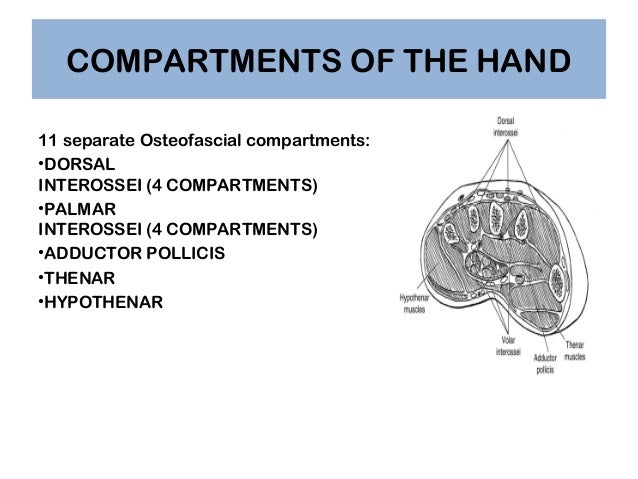
17 A swollen hand, tense on palpation, in an intrinsic minimus position (i.e., extension of the metacarpophalangeal joints and flexion of the IP joints) strongly indicates this condition. Hence, compartment syndrome is diagnosed on the basis of a high degree of clinical suspicion. Dorsal and mobile wad compartment syndrome may not present with the classic signs. intrinsic muscles whose muscle bellies are located within the hand.
#Compartments of hand how to
Muscles of the hand can be divided into: extrinsic muscles whose tendons arise from muscle bellies within the forearm, and. Learn about the compartments of the hand, their associated pathologies, and how to diagnose them. Paresis and pallor appear very late, and pulselessness, usually the last sign to appear, may be present early in patients with injury to major arteries 17 By the time all six symptoms manifest, the patient has been irreparably harmed. Hand movement is complex and occurs across many joints, including those involved in wrist flexion. What structures can we see at the wrist and hand The 6 dorsal extensor compartments The dorsal recess of the radiocarpal, ulnocarpal and distal radioulnar. Paresthesia is an important early sensitive sign but lacks specificity. 15 Pressure refers to increased tension on palpation of the extremity. Passive extension of the little finger will cause pain in hypothenar eminence.

The dorsal interossei muscles consist of four short muscles that attach to the adjacent sides of metacarpals 1-4. They are found on the dorsal aspect of the hand occupying the space between the metacarpal bones, along with the palmar interossei muscles. Pain will be noted with passive abduction and extension of the thumb. The dorsal interossei muscles are short bipennate intrinsic muscles of the hand. The persistence of acute surgical infections of the hand and wrist depends on patient and microbiology factors, as well as mechanism of bacteria inoculation and. Although benign, it can often cause localized pain and finger stiffness. Compartment syndrome of the hand and fingers will present itself as hypoesthesia on the volar surface of the fingers, tenderness in the palm, and weakness of thumb opposition and limited flexion.

The “6 Ps” (i.e., pain, pressure, paresthesia, paresis, pallor, and pulselessness) should be assessed. Lipoma of an extensor tendon compartment is an exceedingly rare tumor of the hand. 16 Paresthesia and pain disproportionate to the injury or increasing levels of pain following treatment are initial indicators that should alert the physician to the possibility of compartment syndrome. Anatomic variations of the hand, multiple compartment involvement, the presence of other injuries, or an obtunded patient make it difficult to predict physical findings of compartment syndrome.


 0 kommentar(er)
0 kommentar(er)
